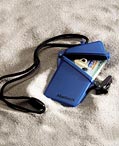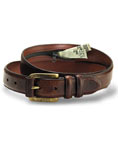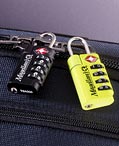Picture a fanny pack (Brits: picture a bum bag). Now picture Wiley E. Coyote running over it with a steamroller. That's your moneybelt.
This portable safe is a flat pouch with a zippered compartment (the better ones have two compartments) that holds your passport, plane ticket/voucher, railpass, travelers checks, bank ATM cards and credit cards, B&B or hotel vouchers, emergency cash, backup info sheet, and anything else that would ruin your trip were you to lose it to pickpockets or bad luck.
You zipper all that stuff in there, buckle it around your waist under your clothes, and ain't no pickpocket getting to your goodies.
In your wallet, carry merely a single day's spending money—maybe €40–€60. Replenish this as needed from your stash in the moneybelt.
When you do need, say, a credit card, you can just discreetly untuck the top of the moneybelt from your shirt and pants, unzip it, and slide the card out. (Or excuse yourself to the bathroom.)
Slightly annoying? Yes. Worth it to know your precious documents and cards are safe from pickpockets? Definitely.
Up above, I described
the classic, waist belt kind of moneybelt, but there are other flavors, including one that hangs
around your neck like a tiny purse (unless you have six-pack abs, this
tends to accentuate your belly with a big rectangle), one you strap to your ankle (pretty small), and one that attaches to your belt by a loop and hangs down your pant leg (also small, and awkward
in that you have to reach waaay down your pants to get at it).
There are also various
silly little models, including those that strap to your wrist (not large enough
to hold a passport, hence pointless, to my mind, but some folks like them for carrying around a secret stash of cash and such), plus a sort that clips to your bra (again, too small for passports, but handy perhaps for carrying somecash, credit cards, and an ID when going out without your purse).

 Also, if you're going anywhere where swimming might feature in your plans, I recommend carrying along a tiny waterproof moneybelt into which you can put your money, credit cards, and other moneybelt items, seal shut, and take with you into the water.
Also, if you're going anywhere where swimming might feature in your plans, I recommend carrying along a tiny waterproof moneybelt into which you can put your money, credit cards, and other moneybelt items, seal shut, and take with you into the water.
There are two kinds. I've always loved the surf safe (pictured at left), a hard plastic case on a lanyard, but sadly it is too small to fit a passport—just cash, credit cards, and like-sized IDs—so I usually end up taking a flat, flexible Splashsak pouch, which works like a waterproof moneybelt (pictured to the right).
 In addition to your moneybelt
In addition to your moneybelt for carrying your passport, documents, and credit cards,
you might also want to wear a traditional leather belt that just so happens to have a hidden zipper on the inside—perfect for hiding some emergency cash, traveler's checks, and an extra copy of that backup info sheet (a photocopy of your passport and other important documents); just fold the bills and such into thirds the long way, layer them, and they'll all fit.
No matter which kind you get, always, always, always wear your moneybelt underneath your clothes, as nature intended it. Sure, they're a pain to get into as you must either reach down your shirt or down the front of your pants every time you want to pay a big restaurant bill, hit the ATM, or check into a hotel.
But keeping this sucker tucked away is the only way it'll work. It’s not that your stuff is "hidden" this way—every thief in Italy knows about Americans and their moneybelts—it's just that it keeps your valuable documents inaccessible to them.
I see countless travelers wearing the waist style on top of their pants like the world's flattest fannypack, or the neck kind bouncing around on their belly like a tiny purse. You can even see through the thin nylon fabric of the things to their passport, traveler's checks, and folded up wad of emergency $20s. Stupid, stupid, stupid.
Exposed like this, moneybelts actually make your most precious documents even less safe than they would be if you simply stuffed them in your pockets, the tops sticking out, with convenient little loops attached so pickpocket can more easily relieve you of them.
I tend to go up these people on the street and scold them, so please don't do it yourself. Nothing spoils your day like a deranged and testy travel writer accosting you on a Roman bus and yelling at you about your moneybelt habits.
Incidentally, please leave at home all unnecessary wallet items—library card, gas station credit cards, your membership in the "cheese of the month club" that's good for 10% off on gouda, etc. There's no reason to carry them around the streets of Rome, Florence, and Venice. While we're on the subject, leave at home all keys but your main house key—that you keep tucked away in your bag somewhere safe.
GEAR, CLOTHES, & BAGS
Gear & clothing: REI.com, eBags.com, Backwoods.com, Travelsmith.com, LLBean.com
, Magellans.com
Luggage: eBags.com, REI.com, Backwoods.com
Electronic converters: REI.com, Travelsmith.com
Pack for ultimate mobility, versatility, and necessity. Make travek an exercie in simplifying your material needs.
When in doubt, leave it at home. Whatever you forgot or discover on the road you need (sunscreen, bathing suit, sandals) you can also just buy it in Italy—and have a nifty extra souvenir of daily life to bring home (I often come home with odd, foreign brands of toothpaste).
Speaking of which: you shoudl have a little space in your pack for accumulating souvenirs.
If, as you travel, you find yourself running out of room, stop at any post office to ship home the personal items you've found you didn't need, or just before flying home, mail your dirty laundry to yourself. This way, you can carry your new purchases instead of entrusting them to the Italian postal system.
Trust me, you'll be thankful later when you easily shoulder you bag and zip off to your hotel while the guy who sat next to you on the plane gets a hernia just trying to get his luggage out of the airport.
Remember: Clothes take up the most room in your luggage, so be stingy with what you take. Take a maximum of 2–3 each of pants and shirts that can all mix and match toegther.
Believe me, it's easier to do a bit of laundry in your room every few nights than lug around a ton of extra clothing.
Only your immediate traveling companions will know you've been wearing the same outfit for the past three countries.
Socks, T-shirts, and underwear—the clothes that ripen quickly—are the easiest items to wash out and dry overnight.
Keep your all valuables in a moneybelt: one of these large, flat, zippered pouched you wear under your clothes.
A moneybelt is like a wearable safe for your passport, credit cards, bank/ATM cards, driver's license, plane tickets, railpass, extra cash, and other important documents.
In your wallet, carry only a single day's spending money—maybe €40–€60. (Replenish this as needed from your stash in the moneybelt.) » more
 Get as many tiny travel locks you have zippered compartments on your pack and daypack. Make sure it is one of the special combination locks that have a red diamond-like symbol meaning they're TSA-friendly (baggage screeners carry a secret code and a special back-door key so they can open the lock if they feel the need to paw through your valuables and dirty undies).
Get as many tiny travel locks you have zippered compartments on your pack and daypack. Make sure it is one of the special combination locks that have a red diamond-like symbol meaning they're TSA-friendly (baggage screeners carry a secret code and a special back-door key so they can open the lock if they feel the need to paw through your valuables and dirty undies). Share this page
Search ReidsItaly.com
GEAR, CLOTHES, & BAGS
Gear & clothing: REI.com, eBags.com, Backwoods.com, Travelsmith.com, LLBean.com
, Magellans.com
Luggage: eBags.com, REI.com, Backwoods.com
Electronic converters: REI.com, Travelsmith.com